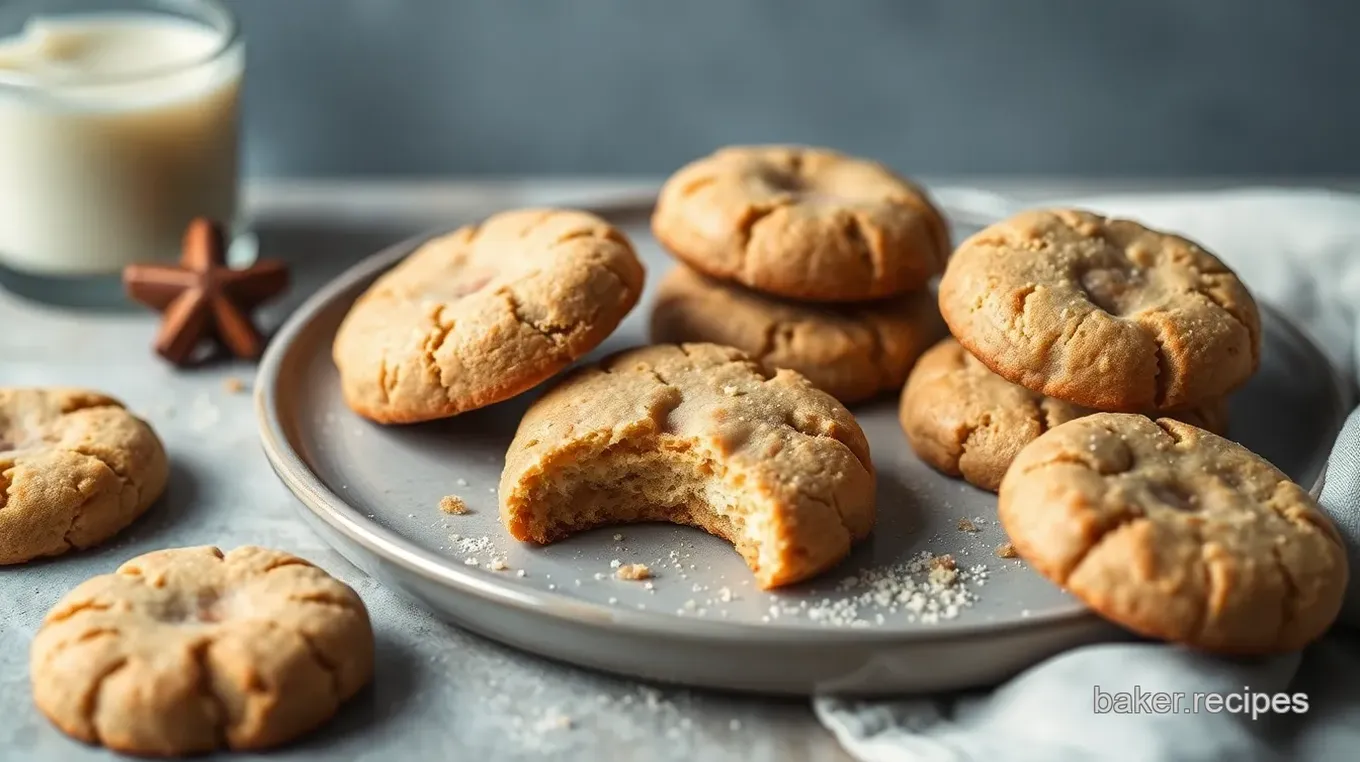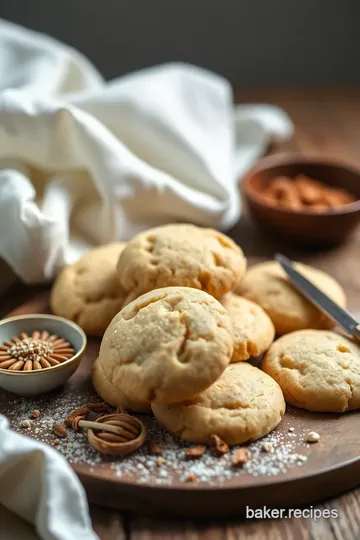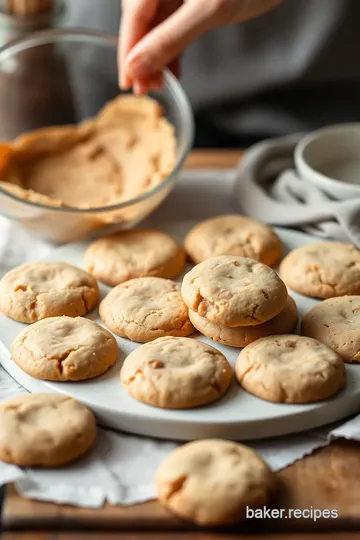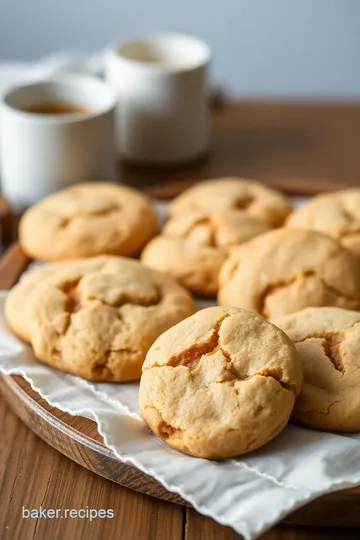Quick Brown Sugar Shortbread Cookies
Craving something sweet? Learn how to bake brown sugar shortbread cookies quick with this easy recipe, perfect for cozy afternoons and yummy snacking!

- Shortbread Love: A Sweet Adventure Begins
- Recipe Overview: Simple Roots and Modern Love
- What’s in It for You? The Sweet Benefits of Shortbread
- Wrap Up: Ready to Bake?
- Your Go-To Guide for Essential Ingredients
- Professional Cooking Method: Mastering the Art of Baking Brown Sugar Shortbread Cookies
- Elevate Your Baking with Brown Sugar Shortbread Cookies Quick
- Recipe Card
Shortbread Love: A Sweet Adventure Begins
You know how sometimes a smell hits you like a time machine, bringing you back to your childhood? for me, it's the aroma of freshly baked cookies, especially my favorite brown sugar shortbread cookies quick recipe! i remember walking into my grandma's kitchen, the warmth hugging you as you breathed in that buttery goodness.
It's like the world disappears, and all that exists is that sweet moment. i'm pretty sure everyone has a little nostalgic memory like that because hey, who doesn’t love cookies?
Shortbread is a classic, right? but let me tell you, when you add brown sugar, it takes the traditional flavor to a whole new level.
These cookies are not just about tradition; they’re quick and easy, perfect for last-minute sweet cravings. let's dive into this mouthwatering adventure together!
Recipe Overview: Simple Roots and Modern Love
Did you know shortbread dates back to scotland in the 12th century? that’s right! back then, it was usually made with just three ingredients: butter, sugar, and flour.
Fast forward to today, and shortbread, especially the brown sugar shortbread cookies , has become a household staple. it's loved not only for its rich and buttery flavor but also for how easy it is to whip up at home.
Let’s talk about the details. you can prep these easy shortbread cookies in about 15 minutes , with a bit of chilling time, and they bake up in about 12- 15 minutes .
In under an hour, you can have around 24 cookies that are perfect for sharing or devouring all by yourself! and honestly, who can resist cookies that are melt-in-your-mouth good?
In terms of cost? you’re looking at a budget-friendly treat, just a few bucks for all those basic ingredients. plus, they yield a decent batch, so they're great for a party or just a cozy night in.
What’s in It for You? The Sweet Benefits of Shortbread
Now, let’s be real—cookies are not just about taste; they have their perks! first off, brown sugar brings a unique richness that white sugar just can’t compete with.
These melt-in-your-mouth cookies also have a crunchy texture on the outside, while being soft and crumbly inside. seriously, it's like biting into a little piece of heaven.
With all that buttery goodness, these cookies are perfect for those special occasions—like afternoon tea , holiday gatherings, or even just a pick-me-up during a long workday.
The best part? they pair beautifully with pretty much anything—tea, coffee, or heck, just by themselves!
Looking for those extra cookie baking tips? Here's a pro tip: after baking, try sprinkling a bit of sea salt on top. It totally elevates the flavor!
Wrap Up: Ready to Bake?
So, if you’re ready to embrace this sweet simplicity and dive into an easy baking adventure, stick around! next, i’ll break down the ingredients that make these best shortbread cookies come to life.
Trust me; you’ll want to keep these in your cookie jar!
Let’s get to it, and soon enough, you’ll have your own batch of these irresistible brown sugar shortbread cookies cooling on the rack.
You'll be the star of the kitchen, and maybe even the whole block! ready? grab your apron, and let's get baking!

Your Go-To Guide for Essential Ingredients
When it comes to cooking, having the right essential ingredients in your pantry can make all the difference. honestly, it’s like hitting the jackpot when you know exactly what you need to whip up something delicious! let’s break down what you should always have on hand to make your kitchen adventures a breeze.
Get the Basics Right with Premium Core Components
First off, let’s talk about the premium core components . You want to know the detailed measurements ? Here’s a quick cheat sheet:
- Butter: 1 cup (226g) – Unsalted, of course! That rich flavor is everything.
- Brown Sugar: 1 cup (220g) – The secret to those incredible melt-in-your-mouth cookies.
These ingredients are quality indicators themselves. when shopping, look for freshness tips like smooth, shiny butter and evenly packed brown sugar.
And don't forget storage guidelines! keep butter in the fridge and store sugar in a cool, dry place. the shelf life can be a game changer—brown sugar can last forever if stored properly, while butter should be used within a few months.
Spice Things Up with Signature Seasoning Blends
Now, what’s a recipe without a little pizzazz? that’s where your signature seasoning blend comes into play. think of your essential spice combinations like salt and pepper or cinnamon and sugar! they can truly elevate your easy shortbread cookies from basic to the best shortbread cookies ever.
For herbs, pairing options like basil and parsley can brighten up any savory dish. and let’s not forget those regional variations .
Maybe you want a spicy kick? try adding some cayenne! the beauty of cooking is exploring different flavors, like throwing in some cloves for that warm holiday feeling.
Smart Substitutions That Save the Day
Sometimes, you may find yourself in a pickle with what you have on hand. fear not! when it comes to smart substitutions , i’ve got your back.
For instance, if you run out of flour while making those homemade shortbread cookies , grab some cornstarch. i promise you it’ll work!
Got dietary modifications? Use coconut oil instead of butter for a dairy-free treat, or swap brown sugar for honey—it’s a total game changer!
And guess what? If you feel like being adventurous, try seasonal options! You can experiment with pumpkin spice in the fall or lemon zest in the summer.
Kitchen Equipment Essentials – Tools You Need
Having the right tools makes all the difference, doesn’t it? here are the must-have tools for your arsenal. you can’t go wrong with a good mixing bowl and a reliable hand mixer or stand mixer.
Seriously—those are lifesavers!
If you don’t have a rolling pin, no sweat! a water bottle will do in a pinch. when it comes time for baking, having parchment paper on hand will save you from messy spills.
Plus, it makes clean-up super easy.
When it comes to cookie baking tips, make sure you have a cookie cutter. I love getting creative with my DIY cookie cutter ideas!
The Freshest Cookies Await
Alright, now that we’ve covered the essentials, let’s roll into making those bake brown sugar shortbread cookies quick ! with just a few ingredients, you’ll have buttery, soft and crumbly cookies that melt in your mouth.
This shortbread recipe is not just easy and approachable for beginners, but it’s also the perfect entryway into baking. so grab your butter and sugar mix, and let’s whip up something phenomenal together.
By the time you finish, who knows? you might just create the next family favorite for afternoon tea treats or as a late-night sweet snack!
You know what they say—life is too short to skip dessert!
Professional Cooking Method: Mastering the Art of Baking Brown Sugar Shortbread Cookies
Baking can sometimes feel like rocket science, right? but truth be told, it’s all about having a solid plan. get ready to whip up some quick brown sugar shortbread cookies like a pro! this treat isn’t just any cookie; it’s a melt-in-your-mouth experience that’s as simple as it is satisfying.
Grab your apron and let’s dive in!
Essential Preparation Steps
Mise en place is key, my friend! this fancy french phrase just means getting everything ready before you start cooking.
For our shortbread cookies, measure out 1 cup of unsalted butter , 1 cup of brown sugar , 2 cups of all-purpose flour , and other ingredients in advance.
Trust me, it saves you from scrambling around the kitchen later!
Time management tips? set a timer! once you’ve prepped everything, keep an eye on your clock. shortbread usually takes about 12- 15 minutes to bake, so do a little dance while you wait.
Seriously, it helps pass the time.
Stay organized by cleaning as you go. when you mix up that butter and brown sugar , put away the flour and other ingredients that you won’t need anymore.
Your kitchen will thank you.
And let’s not forget about safety. remember to keep your workspace tidy! if you’re using a mixer, watch those fingers, and keep your oven mitts handy.
Nothing ruins cookie-making like a burnt tongue!
Step-by-Step Process
Here’s where we get to the nitty-gritty! Follow these numbered steps for cookie perfection:
-
Preheat your oven to 350° F ( 175° C) . That’s super important! An oven that’s too cool won’t give you that perfect, crunchy edge.
-
Cream the butter and brown sugar until light and fluffy. This usually takes about 3- 5 minutes with a hand or stand mixer.
-
Gradually mix in the dry ingredients, which are your flour and a pinch of salt. Just keep mixing until a soft dough forms!
-
Chill it out! Wrap that dough in plastic wrap and toss it in the fridge for about 30 minutes . Chilling helps keep your cookies from spreading too much.
-
Roll it out to about 1/4 inch thick. Grab a cookie cutter or a knife and cut those cookies into adorable shapes.
-
Bake for 12- 15 minutes , or until those edges are just lightly golden. Trust your nose; it’ll guide you!
-
Let them cool for 5 minutes on the baking sheet before transferring them to a wire rack.
Expert Techniques
Want to know how the pros do it? For best shortbread cookies , here are critical steps to follow:
-
Always soften your butter but don’t let it melt! This ensures a smooth texture without being too wet.
-
Check for doneness by looking for those crispy edges. The center will generally still look a bit pale; that’s okay!
-
If you’re feeling adventurous, try adding chocolate chips or nuts for a delightful twist. That’s how you create spiced shortbread or nutty desserts !
And if things don’t quite go as planned, don’t sweat it! Cookie disasters happen. Stuck dough? Add a bit more flour. Too dry? A splash of milk works wonders.
Success Strategies
Avoid common pitfall number one: over-mixing! Gently mix the dough, and you’re golden.
Another pro tip? Control your chilling time . If you skip that step, you could end up with cookie blobs instead of cute shapes!
For incredible results, try to chill your dough longer than 30 minutes . The longer, the better, trust me!
Lastly, make-ahead options are perfect. Roll out your cookies, cut them, and then freeze them. Pop them in the oven right from the freezer and bam! Fresh cookies for those surprise guests.
So there you have it! You’re all set to make some seriously scrumptious brown sugar shortbread cookies quick. Remember to relax and enjoy the process—after all, baking should be fun! Stay tuned for additional information, just in case you want to jazz things up or discover more about the world of cookies!

Elevate Your Baking with Brown Sugar Shortbread Cookies Quick
Oh my gosh! if you’ve never tried bake brown sugar shortbread cookies quick , you’re totally missing out. shortbread cookies are like the cozy, comforting blanket of the cookie world.
They’re simple, they’re buttery, and they scream afternoon tea vibes—especially with a warm cup of your favorite brew. let’s dive into some extra tips and tricks that’ll make your baking adventure even more enjoyable!
Pro Tips & Secrets
First off, here’s a little insider secret: always soften your butter but don’t let it melt. seriously, this is a game changer for that rich, melt-in-your-mouth texture.
When you’re creaming butter and brown sugar, you want it fluffy, not soupy.
Now, about saving time—chilling your dough is a must! wrap it up and pop it in the fridge for about 30 minutes.
Not only does it help the cookies keep their shape, but it also allows those flavors to really meld together.
It’s like giving your cookies a spa day!
For a flavor boost, try adding a splash of vanilla extract . a little dash goes a long way in enhancing that deep sweetness of brown sugar.
If you’re feeling adventurous, toss in some cinnamon or nutmeg for a warm twist. who needs fancy flavorings when a few spices can do the trick?
Perfect Presentation
Okay, let’s get classy for a hot minute. presentation is everything, right? first, when you’re plating those easy shortbread cookies , consider stacking them on a pretty plate.
Arrange them in a little pyramid and sprinkle with a touch of powdered sugar. instantly fancy!
Garnish ideas? you might sprinkle sea salt on top just before baking. it gives a lovely contrast to the sweetness.
Or how about adding a slice of caramel on the side? both look incredible and add that extra flair. and trust me, guests will be blown away!
Playing with color combinations can elevate your cookie game as well. think about pairing these delicious cookies with a bright berry compote.
That pop of color not only makes the plate vibrant but also adds a flavor explosion.
Storage & Make-Ahead
Let’s talk about keeping those melt-in-your-mouth cookies fresh! once baked, let them cool completely before storing. the best part? these cookies can be kept in an airtight container for about a week—if they last that long! just remember, keeping them stored in a cool place keeps them nice and crunchy.
If you’re the type who loves to plan ahead (holla at meal preppers!), you can totally make the dough in advance.
Just wrap it up tight and freeze it. when you're ready for those fresh cookies, just thaw it, slice, and bake.
Easy peasy!
Creative Variations
Got a sweet tooth for something different? try adding chocolate chips for a classic twist or mix in some nuts for those nutty shortbread desserts! you could even create spiced shortbread cookies by incorporating some seasonal flavors—all you need is a little creativity.
For those of you who need gluten-free options, swap the all-purpose flour for a gluten-free blend. There are loads available now that taste just as good!
Complete Nutrition Guide
Okay, health nuts, i got you! while shortbread cookies are definitely a treat, understanding the nutrition behind them helps. each cookie has about 90 calories .
Not too bad for a sweet snack, right? they’re moderate in sugar and filled with that rich, buttery goodness. just make sure to enjoy them in moderation.
If you’re watching your portion sizes, these babies are great for that. Each cookie is a satisfying little bite of happiness!
Expert FAQ Solutions
So, what if things don’t go as planned? if your dough seems too crumbly, a splash of milk can help bring it all together.
Not getting the right texture? maybe you baked them a tad too long—keep an eye out for those slight golden edges.
And if you’re ever in doubt about your baking skills, remember: practice makes perfect! Each batch you whip up just gets better and better.
Conclusion
In the end, making bake brown sugar shortbread cookies quick is all about having fun and finding what works for you.
Easy baking for beginners? you bet! so go ahead, roll up those sleeves, and embrace your inner baker. your kitchen is about to smell amazing, and trust me, everyone’s gonna want a taste of your homemade goodies.
Happy baking, my friends!

Quick Brown Sugar Shortbread Cookies Card

⚖️ Ingredients:
- 1 cup (226g) unsalted butter, softened
- 1 cup (220g) brown sugar, packed
- 2 cups (240g) all-purpose flour
- 1/4 teaspoon salt
- 1/2 teaspoon vanilla extract
🥄 Instructions:
- Step 1: Preheat your oven to 350°F (175°C) and line a baking sheet with parchment paper.
- Step 2: In a mixing bowl, beat the softened butter and brown sugar together until light and fluffy.
- Step 3: Gradually add the all-purpose flour and salt to the butter mixture. Mix until a soft dough forms.
- Step 4: Stir in the vanilla extract until evenly distributed.
- Step 5: Wrap the dough in plastic wrap and refrigerate for 30 minutes to firm up.
- Step 6: Roll out the chilled dough on a lightly floured surface to about 1/4 inch thickness. Use a cookie cutter or knife to cut out cookies.
- Step 7: Transfer cookies to the prepared baking sheet, spacing them about 1 inch apart. Bake for 12-15 minutes, or until the edges are lightly golden.
- Step 8: Allow cookies to cool on the baking sheet for 5 minutes before transferring them to a wire rack to cool completely. Store in an airtight container.
Previous Recipe: Ultimate Decadent Bake Oreo Brownies with Creamy Topping: 7 Ways to Impress!
Next Recipe: How to Create Easy Slow Cooker Turkey Meatballs - Healthy Delight
